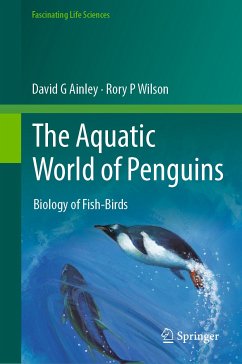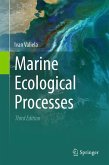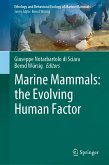

Alle Infos zum eBook verschenken

- Format: PDF
- Merkliste
- Auf die Merkliste
- Bewerten Bewerten
- Teilen
- Produkt teilen
- Produkterinnerung
- Produkterinnerung

Hier können Sie sich einloggen

Bitte loggen Sie sich zunächst in Ihr Kundenkonto ein oder registrieren Sie sich bei bücher.de, um das eBook-Abo tolino select nutzen zu können.
Centuries ago, when penguins were first encountered by European explorers, they were not thought to be birds but rather a fish-like relative. Subsequent accumulation of knowledge has shown penguins to be an avian species with unrivaled aquatic attributes, owing to a number of evolutionary adaptations: shape change, low drag, ability to regulate buoyancy, and extraordinary surface compliancy from their featheration. They are indeed the most extremely specialized diving bird, having given up flight (which otherwise is hugely advantageous) to the benefit of underwater prowess (such as speed,…mehr
- Geräte: PC
- ohne Kopierschutz
- eBook Hilfe
- Größe: 37.34MB
![Marine Ecological Processes (eBook, PDF) Marine Ecological Processes (eBook, PDF)]() Ivan ValielaMarine Ecological Processes (eBook, PDF)69,95 €
Ivan ValielaMarine Ecological Processes (eBook, PDF)69,95 €![Ethology and Behavioral Ecology of Mysticetes (eBook, PDF) Ethology and Behavioral Ecology of Mysticetes (eBook, PDF)]() Ethology and Behavioral Ecology of Mysticetes (eBook, PDF)121,95 €
Ethology and Behavioral Ecology of Mysticetes (eBook, PDF)121,95 €![Ethology and Behavioral Ecology of Otariids and the Odobenid (eBook, PDF) Ethology and Behavioral Ecology of Otariids and the Odobenid (eBook, PDF)]() Ethology and Behavioral Ecology of Otariids and the Odobenid (eBook, PDF)113,95 €
Ethology and Behavioral Ecology of Otariids and the Odobenid (eBook, PDF)113,95 €![Ethology and Behavioral Ecology of Sea Otters and Polar Bears (eBook, PDF) Ethology and Behavioral Ecology of Sea Otters and Polar Bears (eBook, PDF)]() Ethology and Behavioral Ecology of Sea Otters and Polar Bears (eBook, PDF)129,95 €
Ethology and Behavioral Ecology of Sea Otters and Polar Bears (eBook, PDF)129,95 €- -29%11
![Marine Mammals: the Evolving Human Factor (eBook, PDF) Marine Mammals: the Evolving Human Factor (eBook, PDF)]() Marine Mammals: the Evolving Human Factor (eBook, PDF)129,95 €
Marine Mammals: the Evolving Human Factor (eBook, PDF)129,95 € ![Ethology and Behavioral Ecology of Sirenia (eBook, PDF) Ethology and Behavioral Ecology of Sirenia (eBook, PDF)]() Ethology and Behavioral Ecology of Sirenia (eBook, PDF)113,95 €
Ethology and Behavioral Ecology of Sirenia (eBook, PDF)113,95 €![Urban Foraging in the Changing World (eBook, PDF) Urban Foraging in the Changing World (eBook, PDF)]() Urban Foraging in the Changing World (eBook, PDF)161,95 €
Urban Foraging in the Changing World (eBook, PDF)161,95 €-
-
-
While a number of "penguin books" cover the natural history, mainly of breeding aspects, few address in much detail the incredible aquatic nature of these creatures. A huge amount of information has been amassed over recent past decades thanks to dramatic advances in microelectronics, bio-logging and maturation of some long-term studies of penguin life history. This work represents an integration of all these data with charts, maps and graphs, along with richly illustrated photos by experts in the field.
Dieser Download kann aus rechtlichen Gründen nur mit Rechnungsadresse in A, B, BG, CY, CZ, D, DK, EW, E, FIN, F, GR, HR, H, IRL, I, LT, L, LR, M, NL, PL, P, R, S, SLO, SK ausgeliefert werden.
- Produktdetails
- Verlag: Springer International Publishing
- Seitenzahl: 567
- Erscheinungstermin: 10. November 2023
- Englisch
- ISBN-13: 9783031339905
- Artikelnr.: 69430589
- Verlag: Springer International Publishing
- Seitenzahl: 567
- Erscheinungstermin: 10. November 2023
- Englisch
- ISBN-13: 9783031339905
- Artikelnr.: 69430589
- Herstellerkennzeichnung Die Herstellerinformationen sind derzeit nicht verfügbar.
Es gelten unsere Allgemeinen Geschäftsbedingungen: www.buecher.de/agb
Impressum
www.buecher.de ist ein Internetauftritt der buecher.de internetstores GmbH
Geschäftsführung: Monica Sawhney | Roland Kölbl | Günter Hilger
Sitz der Gesellschaft: Batheyer Straße 115 - 117, 58099 Hagen
Postanschrift: Bürgermeister-Wegele-Str. 12, 86167 Augsburg
Amtsgericht Hagen HRB 13257
Steuernummer: 321/5800/1497
USt-IdNr: DE450055826
Bitte wählen Sie Ihr Anliegen aus.
Rechnungen
Retourenschein anfordern
Bestellstatus
Storno
Sollte Ihr Anliegen nicht dabei sein, finden Sie weitere Auskünfte zu Ihren Fragen auf unseren Serviceseiten.
Serviceseiten
Schließen







